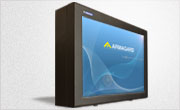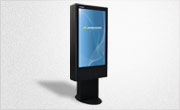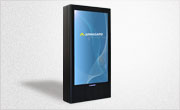Outdoor Digital Signage – Cooling Matters
Posted by: Richard Williams | Posted on: | 0 Comments
There are many aspects to providing an outdoor screen need thinking of before embarking on any outdoor digital signage project. Protection is perhaps the most obvious, with weather and physical impacts obvious threats to any outdoor display.
While weatherization is essential for any screen to function outdoors with rain and other weather elements capable of disabling a TV display, another aspect of protection is just as important to think about—temperature.
All screens, whether indoors or out, generate heat, and dissipation of this heat is necessary to prevent overheating of the screen. An overheating screen will soon fail, but with an outdoor display, letting heat escape proves problematic.
On most indoor screens, such as a home TV, small vents situated on the device allow the screen to breathe. Combined with internal fans, hot air generated by the screen is transferred out of these vents, preventing overheating; however, when a screen is taken outdoors, leaving vents exposed could lead to weather elements, such as rain, getting inside the device.
Keeping an outdoor screen cool, while also keeping it dry, therefore, can be a challenge.
LCD enclosures deal with this heat transfer in a rather unique way. As the screen is housed inside the enclosure, the normal vents of the TV omit the hot air. Cooling fans inside the LCD enclosure then transfer this heat to the enclosures vent; however, rather than just have exposed slots for the air to escape, LCD enclosure have cleverly shaped channels that allow air to blow out, but no moisture or other elements to get inside.
In extreme heat, more measures than just cooling fans are required. Air conditioners are an option for locations with very high temperatures; however, in some locations the opposite can be the problem.
When temperatures drop too low, preventing the screen from freezing becomes the biggest hurdle. LCD enclosures often use insulation to trap the dissipated heat from the screen to keep the screens warm, but in many locations the use of heaters is the only option to prevent freezing.
Post shortlink:
Popular Products
LCD Enclosure
Need armor for your LCD/LED screen(s)? Outdoors or inside the versatile LCD enclosure protects against thieves, vandals & the weather. Installation idea: NFL stadiums.
Outdoor Digital Signage
Exclusive 46” outdoor screen protection. Dubbed the ‘Totem’, due to its distinct design, it repels damage threats, but attracts audiences. Installation idea: Drive-thru restaurants.
Portrait Flat Panel Enclosure
Safeguard your eye-level advertising display screen(s), indoors or outdoors. Completely customizable, add exciting features like touch screen technology. Installation idea: Restaurant frontages.
Indoor Digital Signage
Popular purchase for retail outlets! Great for ‘point of sale’ persuasion, boost your brand with static & motion advertising from a single unit! Installation idea: Mall of America.




